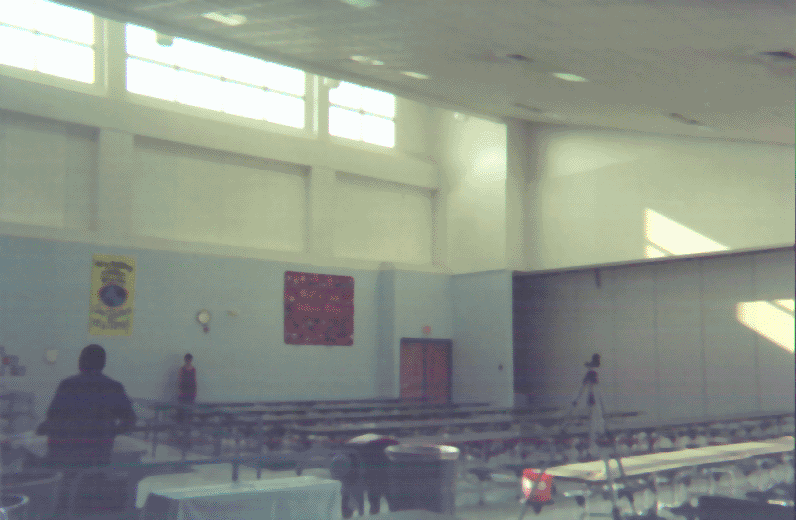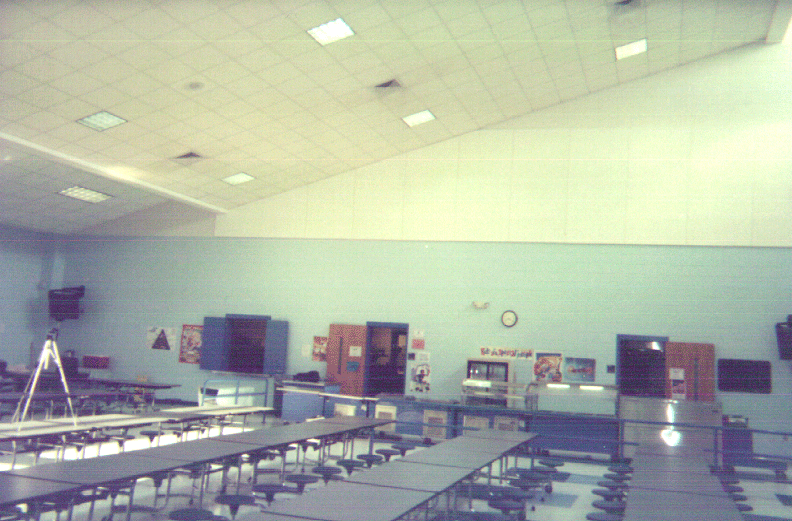![]()
![]()
![]()
[ Lay Language Paper Index | Press Room ]
School cafeteria noise - The impact of room acoustics and speech intelligibility on children's voice levels.
Joseph F. Bridger - joe@stewartacousticalconsultants.com
Stewart Acoustical Consultants
P.O. Box 30461
Raleigh, NC 27622
Popular version of paper 4pAA6
Presented Thursday afternoon, June 6th , 2002
143rd ASA Meeting Pittsurgh, PA
Cafeterias
are often synonymous with noise. If you do an Internet word
search on "cafeteria noise" or "noisy or
loud cafeteria" you would find over 200 entries. A
search on "quiet cafeteria" turns up about 40.
Dictionaries often use noisy cafeterias as an example of the use
of the adjective noisy. Those who study the ability to understand
speech in noise often use what is called "cafeteria
noise" as the noise source. It is a recording of many people
talking at the same time.
This is especially true of the school cafeteria. Parent Teacher
Associations (PTA's) and others call acoustical consultants
looking for answers to this problem. Some cafeterias exceed the
OSHA noise level of 85 dBA and causing cafeterias to begin
accumulating noise dose. When visiting and measuring noise at one
school, a frustrated teacher screamed into the microphone on the
sound level meter (paraphrased) "It sure is loud in here
isn't it?"
So what is the
primary underlying phenomenon?
Research has shown that signal to noise ratio (S/N)
is the number one factor contributing to changes in voice levels
used by adults. S/N is simply the difference in
sound level between the signal (what someone wants to hear) and
the background noise (what is interfering with someone hearing
the signal). The S/N in a cafeteria is the
difference in sound level of the person talking to the noise of
everyone else talking measured at the listener's ear. When the S/N
is poor, someone cannot be heard over the "cafeteria
noise", the response is often to raise one's voice. This
makes sense, after all S/N is also the primary
factor affecting speech intelligibility (the ability to
understand speech) in this setting. It has been thought that
adults will all then raise their voices to some maximum
sustainable voice level, until listening conditions improve
again.
S/N
in a cafeteria is controlled by the number of people talking, the
total sound absorption in the room (some surfaces absorb sound,
some mainly reflect sound), and the seating density (how close
the different noise sources are). We know that small changes in S/N
can result in large changes in the understanding of speech. This
could possibly mean people may modify their voice levels in
response to even small changes in S/N.
Click
on the three audio file examples below with different S/N
ratios to hear the difference a small change in S/N
can make.
Poor Signal to Noise
Marginal Signal to Noise
Better
Signal to Noise
Why are some restaurants quiet and school cafeterias
noisy? For starters, classroom acoustics research has
shown that children have a much greater difficulty understanding
teachers and each other in noise and reverberation than adults
do. Reverberation is the time rate of sound decay in a room. It
is the liveliness or 'echoey' (made up word) character that is
found especially in large rooms with mostly hard surfaces such as
the typical large gym. In addition, the number of children in a
cafeteria and seating densities are much greater than in adult
cafeterias and restaurants. Quiet restaurants and adult
cafeterias also have full acoustical ceilings, carpet, and padded
furniture. Most school cafeterias have no more than a basic
acoustical ceiling with mediocre sound absorption properties.
Less absorption, more people talking, greater seating densities,
and greater inherent difficulty understanding speech all mean
much louder cafeterias.
What can be done about it? There has been
anecdotal evidence that adults respond to improved S/N
by lowering their voices, even if conditions are still not ideal.
If this is true, and if it is also true for children, it could
mean that, even a small improvement in S/N would
result in children also lowering their voices, and therefore
lower noise levels. To test this idea, noise levels and other
relevant information to determine the acoustics of the space were
collected and analyzed from 19 schools, of which 13 were
elementary schools. 5 minute median broadband A-weighted noise
levels varied from the lower 70's (dB) to the upper 80's (dB).
The analysis of the data showed that children's voice levels are
strongly a function of S/N. Reverberation may
also have a lesser role. Reverberant spaces also tend to have
poor S/N making evaluation difficult. This work
showed that better acoustics (better S/N) result
in less noisy cafeterias and children using lower voices.
How can the S/N be improved? S/N
can be improved by reducing the number of children talking (quiet
periods, reading time etc.), reducing the number of children,
adding sound absorption, or having a lower seating density. Many
of these and other ideas can be implemented in designing better
school cafeterias in initial construction. For instance, the use
of more absorptive and full acoustical ceilings, and the addition
of absorptive wall treatments. Reduction of seating densities.
Reducing the number of kids talking may involve having outdoor
play areas, or spreading lunch service over a larger period. With
existing schools, often answers are limited to looking at adding
sound absorption.
Before
 |
 |
 |
 |
After
This is what happened at Dillard Drive Elementary School in
Raleigh, North Carolina. The A-weighted noise levels were
generally above 80 dB and up to 86.5 dB for 5 minutes at a time
during recent measurements (even higher during the larger study
last year). This school had the highest 5-minute median sound
levels in the study. The room had up to around 230 children at a
given time with a seating density as little as under 15 sq.ft.
per person. The only absorptive surface (other than the kids
themselves) was a partial acoustical ceiling that had very
mediocre sound absorption (probably chosen for fire-rating, not
acoustical quality). The room was very reverberant when empty. It
was a day lit room with a high ceiling (over 30 feet in height at
it's peak). The fire rating required in the existing ceiling made
replacing the panels with a highly absorptive (lower fire-rated)
fiberglass panel not feasible. Instead, a fiberglass ceiling was
added in a lower ceiling area and similar fiberglass panels added
to the walls. Armstrong provided the material. If children did
not change their behavior, the treatment (calculated) would have
reduced levels only 1.7 dB. Instead, levels were reduced between
3-3.5 dB. This can only be from reduced voice levels. This 3-3.5
dB is typically considered a barely noticeable change, but
remember what a small change in S/N can do. So
far, many at Dillard feel it was a definite improvement. One
teacher felt she can now actually tell who is talking too loud
and correct them. One of the PTA members shared high praises
about the change. Of course, with that small a change in sound
level, some have not noticed as much a change. The data from the
other schools suggested a 5 dB change (instead of 3-3.5 dB) would
result. The Dillard measurements after room modifications clearly
is not typical of the other data collected. It may be that the
children will adjust their voices further as time progresses.
So the answer to the question: Are all school cafeterias
created equal? NO. Although quiet cafeterias may be too
much to ask for, certainly less noisy and more pleasant school
cafeterias are achievable.